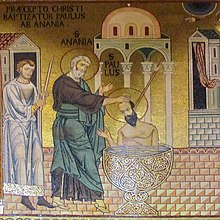Ananias of Damascus
Ananias of Damascus | |
|---|---|

| |
| Apostle, Disciple, Prophet, and Martyr | |
| Born | Unknown (perhaps Damascus) |
| Died | Eleutheropolis (tradition) |
| Venerated in | Roman Catholicism Eastern Orthodox Church Oriental Orthodoxy Anglican Communion Lutheranism |
| Major shrine | Zoravor Surp Astvatsatsin Church in Yerevan, Armenia |
| Feast |
|
Ananias of Damascus (/ˌænəˈnaɪəs/ AN-ə-NY-əs; Ancient Greek: Ἀνανίας, romanized: Ananíās; Aramaic: ܚܢܢܝܐ, romanized: Ḥananyō; "favoured of the LORD") was a disciple of Jesus in Damascus, mentioned in the Acts of the Apostles in the Bible, which describes how he was sent by Jesus to restore the sight of Saul of Tarsus (who later was called Paul the Apostle) and provide him with additional instruction in the way of the Lord.[2]
New Testament narrative of Ananias
[edit]According to Acts 9:10, Ananias was living in Damascus. In Paul's speech in Acts 22, he describes Ananias as "a devout man according to the law, having a good report of all the Jews" that dwelt in Damascus (Acts 22:12). According to F. F. Bruce, this indicates that he was not one of the refugees from the persecution in Jerusalem described in Acts 8:1.[3]
Healing of Saul
[edit]
During Paul's conversion experience, Jesus had told Paul (who was then called Saul) to go into the city and wait. Jesus later spoke to Ananias in a vision, and told him to go to the "street which is called Straight", and ask "in the house of Judas for one called Saul, of Tarsus". (Acts 9:11) Ananias objected that Saul had been persecuting "thy saints", but the Lord told him that Saul was "a chosen vessel unto me, to bear my name before the Gentiles, and kings, and the children of Israel". (Acts 9:15). When Ananias went in to Saul and laid his hands on him, the "scales" of dead tissue on the surface of his eyes fell off, and he looked up at Ananias. After additional instruction, Saul was baptized (Acts 9:18; Acts 22:16).
Biblical status by modern scholars
[edit]
According to Roderick L. Evans, Ananias was a prophet despite being mentioned as a disciple. In his opinion on New Testament prophets, biblical figures who receive a message from God or reveal future events are considered prophets despite alternative titles such as apostle or disciple.[4] Anglican priest and theologian Edward Carus Selwyn recognized Ananias as a prophet as well as one of the seventy disciples and the apostles allocated with different tasks.[5] F. F. Bruce suggests that Ananias "has an honoured place in sacred history, and a special claim upon the gratitude of all who in one way or another have entered into the blessing that stems from the life and work of the great apostle."[6] Ananias is also listed by Hippolytus of Rome and others as one of the seventy disciples whose mission is recorded in Luke 10:1–20.[7]
Ananias is mentioned in late records as having been martyred in Damascus.[8] A tomb is located below the Zoravor Church in Yerevan, Armenia.
Veneration
[edit]Roman Catholicism
[edit]In the 2004 edition of Roman Martyrology, Ananias is listed under 25 January as a saint commemorated on the same day as the Feast of the Conversion of St Paul.[9]
Eastern Orthodoxy
[edit]The Eastern Orthodox Church commemorates Ananias on October 1.[10]
Oriental Orthodoxy
[edit]The Coptic Orthodox Church commemorates Ananias on Paoni 27.[11]
See also
[edit]- House of Saint Ananias, the supposed house of Ananias in Damascus
References
[edit]- ^ Domar: the calendrical and liturgical cycle of the Armenian Apostolic Orthodox Church 2003 A.D. Armenian Orthodox Theological Research Institute, 2002, p. 526.
- ^ Ananias in Acts chapter 9 and chapter 22
- ^ F. F. Bruce, Commentary on the Book of the Acts (Grand Rapids: Eerdmans, 1964), 199. Also found on page 189 of the 1988 edition, ISBN 0-8028-2505-2.
- ^ Evans, Roderick L. (March 1, 2005). The Prophetic Ministry: Exploring the Prophetic Office and Gift. Abundant Truth Publishing. ISBN 9781601411563.
- ^ Selwyn, Edward Carus (1901). St. Luke, the prophet. University of Wisconsin-Madison: Macmillan. p. 31.
Ananias of Damascus a prophet?.
- ^ Bruce, Commentary on the Book of the Acts, 201. Also found on page 186 of the 1988 edition, ISBN 0-8028-2505-2.
- ^ Hippolytus, On the Seventy Apostles (See also Seventy disciples for other lists.)
- ^ E. E.Robinson and Eli Smith, https://www.google.com/books/edition/Biblical_researches_in_Palestine_mount_S/b-Ghd60n2eEC?hl=en&gbpv=1&dq=Anania+Eleutheropolis+martyr&pg=PA414&printsec=frontcover Biblical researches in Palestine, Mount Sinai and Arabia Petraea, John Murray 1841 vol.2 pp.413-414
- ^ Martyrologium Romanum, 2004, Vatican Press (Typis Vaticanis), page 116.
- ^ "Apostle Ananias of the Seventy". www.oca.org. Archived from the original on 2023-08-27. Retrieved 2023-10-22.
- ^ "Commemorations for Paona 27". www.copticchurch.net. Archived from the original on 2021-10-23. Retrieved 2023-10-23.
